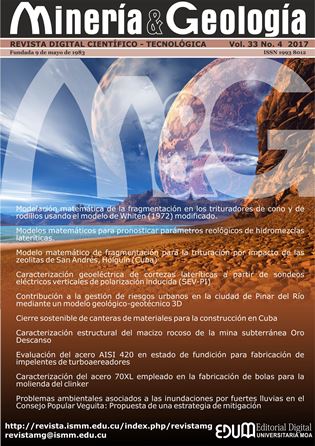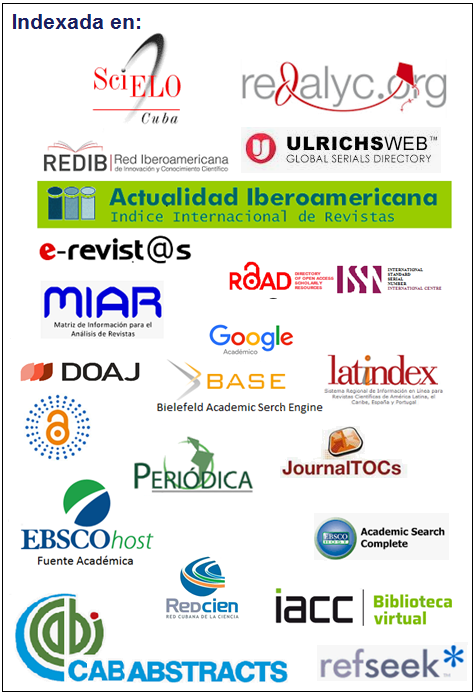Characterization of steel 70XL used in the manufacture of balls for the clinker's milling
Keywords:
gravimetric wear, ball, milling, microstructure, hardness.Abstract
The present article deals with the wear of the balls used for the grinding of the clinker in the processes of obtaining cement. Three specimens of different steel were made: one of steel AISI 4140, with which balls are forged for the milling process; another 70XL steel (70 XL) with normalized, tempered and tempered thermal treatments; and the third, of equal material that the second but without treatment. For the metallographic observation the samples were made with dimensions of 10 mm in diameter and 8 mm in thickness, revealing for AISI 4140 steel a structure of martensitic type with some presence of acicular ferrite. For the 70XL steel without heat treatment the presence of ferrite and cementite was observed, while the steel 70XL with heat treatment showed in the limits of free cementite grain in a pearly matrix, which resulted in a higher hardness (up to HRC 59 , 8) and lower gravimetric wear compared to other materials. Therefore it is recommended as the most suitable for the manufacture of balls for grinding minerals 70XL steel with heat treatment.Downloads
References
ALBERTIN, E.; SINATORA A.; PITALUGA, G. & PARADA, A. 2008: Relación entre factores micro-estructurales e impacto repetido en aleaciones de alto cromo para bolas de molino. Ingeniería Mecánica 11(1): 57-62.
ALCÁNTARA-VALLADARES, J. R. 2008: Diseño práctico de un molino de bolas. Henri Guerra Sotelo (Tutor). Tesis de grado. Escuela Superior de Ingeniería Mecánica y Eléctrica, Unidad profesional Azcapotzalco. 123 p.
BELZUNCE, F. J. 2001: Aceros y fundiciones: estructuras, transformaciones, tratamientos termicos y aplicaciones. Asturia, Universidad de Oviedo, 208 p. Disponible en: http://www.aceroplatea.es/docs/documento138.pdf
CALLISTER, W. D. 2009: Materials Science and Engineering. An Introduction. 5 ed. Félix Varela, La Habana, 871 p.
DIEZ-CICERO, C. J.; FIGUEROA-HERNÁNDEZ, C. R.; ORDÓÑEZ-HERNÁNDEZ, U.; FERNÁNDEZ-LÓPEZ, G. R. & MONDELO-GARCÍA, F. 2008: Influencia de los factores microestructurales en la resistencia al desgaste por deslizamiento de las fundiciones nodulares austemperadas. Ingeniería Mecánica 11(3): 21-28.
DUDA, W. 1977: Manual tecnológico del cemento. Romargraf S. A., Barcelona, 345 p.
OSORIO, A; RESTREPO, G. & MARÍN, J. 2009: Molienda de clinker de cemento: evaluación de la influencia de la velocidad de giro del molino, el tiempo de residencia y la carga de los medios de molienda. Dyna 76(158): 69-77.
PUTATUNDA, S. & BINGI, G. 2012: Influence of step-down austempering process on the fracture toughness of austempered ductile iron. Journal of Materials Science and Engineering with Advanced Technology 5(1): 39-70.
RIVERA-MADRID, I. E. 2013: Balance poblacional en un molino de bolas para una ley de desgaste de tipo exponencial e hiperbólico en tiempos largos. Moises Oswaldo Bustamante Rúa (Tutor). Tesis doctoral. Universidad Nacional de Colombia. 84 p.
SAMPÉN-ARMAS, L. 2003: Pautas para el diseño de partes metálicas resistentes al desgaste. Industrial data 6(2): 74-78.
ROJAS-FERNÁNDEZ, M. V. 2011: Resistencia al desgaste de la aleación ni-resist con adición de aluminio como elemento de aleación. Alberto Velázquez Del Rosario & Félix Ariel Morales Rodríguez (Tutores). Tesis de maestría. Instituto Superior Minero Metalúrgico de Moa. 78 p.
SILOT-MONTERO, Y. 2014: Obtención de bolas para la molienda del clincker a partir de una nueva tecnología de fundición. Yunior Correa Cala (Tutor). Tesis de grado. Instituto Superior Minero Metalúrgico de Moa. 63 p.
Published
How to Cite
Issue
Section
Copyright (c) 2017 Eider Gresesqui-Lobaina, Isnel Rodríguez-González, Tomás Fernández-Columbié

This work is licensed under a Creative Commons Attribution-NonCommercial 4.0 International License.
- Authors retain copyright and guaranteeing the right magazine to be the first publication of the work as licensed under a Creative Commons Attribution-NonCommercial that allows others to share the work with an acknowledgment of the work's authorship and initial publication in this journal.
- Authors may establish separate supplemental agreements for the exclusive distribution version of the work published in the journal (eg, place it in an institutional repository or publish it in a book), with an acknowledgment of its initial publication in this journal.
- Authors are allowed and recommended to disseminate their work through the Internet (e.g., in institutional telematic archives or on their websites) before and during the submission process, which can produce interesting exchanges and increase citations of the published work. (See The effect of open access)




